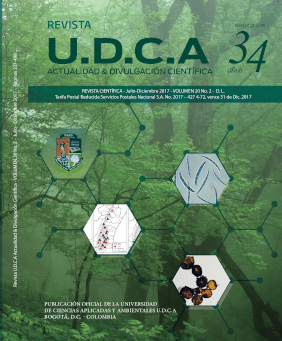Predicción del tiempo en la prueba de 300 metros en patinadores juveniles de rendimiento
Time prediction in the 300 meter test of young performance skaters
Contenido principal del artículo
Resumen
El patinaje de velocidad es una disciplina competitiva de popularidad creciente; sin embargo, la evidencia científica disponible sobre regímenes de entrenamiento, de evaluación y de control es aún limitada. Por la naturaleza de la disciplina es frecuente el uso de pruebas de fuerza explosiva, para la valoración de los deportistas. El objetivo del presente estudio es predecir el rendimiento en la prueba de 300m, en patinadores de velocidad de categoría juvenil pista, de Bogotá, Colombia. Se evaluaron 50 patinadores (37 mujeres y 13 hombres), de la categoría juvenil. Se realizaron carreras de 300m, en la pista de un patinódromo y el tiempo fue cronometrado mediante un sistema de fotoceldas (Microgate Polifemo). Se determinó la altura de los saltos squat (SJ) y contra-movimiento (CMJ), con un sistema óptico de medición (OptoGait, Microgate). Se realizó una prueba de Wingate de 30s, utilizando un ciclo-ergómetro (Cyclus 2, RBM Elektronik-Automation). Se hicieron análisis bivariados y multivariados, utilizando el tiempo de la prueba de 300m, como variable dependiente. El análisis multivariado arrojó que la potencia media relativa (b = -1,163; se b = 0,326) y el salto desde sentadilla (b = -1,137; se b = 0,053) fueron las variables significativas (p<0,01), para predecir el tiempo en la prueba de 300 m (r2 = 0,7). El salto squat y la potencia media relativa han mostrado ser pruebas predictoras del rendimiento en el tiempo de la prueba de 300m, en patinadores juveniles de Bogotá, Colombia.
Palabras clave:
Descargas
Datos de publicación
Perfil evaluadores/as N/D
Declaraciones de autoría
- Sociedad académica
- Universidad de Ciencias Aplicadas UDCA
- Editorial
- Universidad de Ciencias Aplicadas y Ambientales U.D.C.A
Detalles del artículo
Referencias (VER)
ARABATZI, F.; KELLIS, E. 2012. Olympic Weightlifting Training Causes Different Knee Muscle-Coactivation Adaptations Compared with Traditional Weight Training. The Journal of Strength & Conditioning Research, 26(8):2192-2201.
BOHÓRQUEZ-PÁEZ, D.A.; ROJAS-RUÍZ, F.J.; GIMÉNEZ-FUENTES-GUERRA, F.J. 2016. Eficiencia de las salidas frontal y lateral para la prueba de pista 300 metros CRI, patinaje de velocidad sobre ruedas. Orinoquia. 20(1):77-83.
FIELD, A. 2013. Discovering Statistics Using IBM SPSS Statistics. SAGE; 953p.
GLATTHORN, J.F.; GOUGE, S.; NUSSBAUMER, S.; STAUFFACHER, S.; IMPELLIZZERI, F.M.; MAFFIULETTI, N.A. 2011. Validity and reliability of Optojump photoelectric cells for estimating vertical jump height. J. Strength Cond. Res. 25:556-560.
HAUG, W.B.; DRINKWATER, E.J.; MITCHELL, L.J.; CHAPMAN, D.W. 2015. The relationship between start performance and race outcome in elite 500-m short-track speed skating. Int. J. Sports Physiology and Performance. 10(7):902-906.
HAUG, W.B.; SPRATFORD, W.; WILLIAMS, K.J.; CHAPMAN, D.W.; DRINKWATER, E.J. 2015. Differences in End Range of Motion Vertical Jump Kinetic and Kinematic Strategies Between Trained Weightlifters and Elite Short Track Speed Skaters. J. Strength and Conditioning Res. / National Strength & Conditioning Association, 29(9):2488-2496.
HILLIS, T.L.; HOLMAN, S. 2014. The Relationship between Speed and Technical Development in Young Speed Skaters. Int. J. Sports Science & Coaching. 9(2):393-400.
KNECHTLE, B.; KNECHTLE, P.; RÜST, C.A.; SENN, O.; ROSEMANN, T.; LEPERS, R. 2011. Predictor variables of performance in recreational male long-distance inline skaters. J. Sports Sciences, 29(9):959-966.
KONINGS, M.J.; ELFERINK-GEMSER, M.T.; STOTER, I.K.; VAN DER MEER, D.; OTTEN, E.; HETTINGA, F.J. 2015. Performance characteristics of long-track speed skaters: a literature review. Sports Medicine (Auckland, N.Z.). 45(4):505-516.
LOZADA, J.L. 2015. Comparación de las características antropométricas entre patinadores de velocidad medallistas y no medallistas. Actividad Física y Ciencias. 7(1):1-15.
PEYER, K.L.; PIVARNIK, J.M.; EISENMANN, J.C.; VORKAPICH, M. 2011. Physiological characteristics of National Collegiate Athletic Association Division I ice hockey players and their relation to game performance. The J. Strength & Conditioning Res. 25(5):1183-1192.
PIUCCO, T.; DOS SANTOS, S.; DANTAS DE LUCAS, R.; ACHE-DIAS, J. 2015. Nuevo test incremental para patinadores velocistas sobre una superficie plana deslizante: análisis de fiabilidad y comparación con un test de ciclismo. Apunts Medicina de l"Esport. 50(186):57-63.
PIUCCO, T.; DOS SANTOS, S.G.; DE LUCAS, R.D. 2014. Patinação de velocidade in-line: uma revisão sistemática. Rev. Andaluza de Medicina del Deporte. 7(4):162-169.
POTTEIGER, J.A.; SMITH, D.L.; MAIER, M.L.; FOSTER, T.S. 2010. Relationship between body composition, leg strength, anaerobic power, and on-ice skating performance in division I men's hockey athletes. Journal of Strength and Conditioning Research / National Strength & Conditioning Association. 24(7):1755-1762.
Record - FIRS - Fédération Internationale Roller Sports. 2016. Disponible desde Internet en: http://www.rollersports.org/discipline/speed/record (con acceso 08/03/17).
STANGIER, C.; ABEL, T.; HESSE, C.; CLAEN, S.; MIERAU, J.; HOLLMANN, W.; STRÜDER, H.K. 2016. Effects of Cycling vs. Running Training on Endurance Performance in Preparation for Inline Speed Skating. Journal of Strength and Conditioning Research / National Strength & Conditioning Association. 30(6):1597-1606.
STANGIER, C.; ABEL, T.; MIERAU, J.; GUTMANN, B.; HOLLMANN, W.; STRUDER, H.K. 2016. Comparison of sport-specific and non-specific exercise testing in inline speed skating. The Journal of Sports Medicine and Physical Fitness. 56(4):406-414.
STANGIER, C.; ABEL, T.; MIERAU, J.; HOLLMANN, W.; STRÜDER, H.K. 2016. Effects of Cycling Versus Running Training on Sprint and Endurance Capacity in Inline Speed Skating. J. Sports Science & Medicine. 15(1):41-49.
STOTER, I.K.; MACINTOSH, B.R.; FLETCHER, J.R.; POOTZ, S.; ZIJDEWIND, I.; HETTINGA, F.J. 2016. Pacing Strategy, Muscle Fatigue, and Technique in 1500-m Speed-Skating and Cycling Time Trials. Int. J. Sports Physiology and Performance. 11(3):337- 343.
TINWALA, F.; CRONIN, J.; HAEMMERLE, E.; ROSS, A. 2017. Eccentric Strength Training: A Review of the Available Technology. Strength Cond. J. 39(1):32-47.
TURKI, O.; CHAOUACHI, A.; DRINKWATER, E.J.; CHTARA, M.; CHAMARI, K.; AMRI, M.; BEHM, D.G. 2011. Ten minutes of dynamic stretching is sufficient to potentiate vertical jump performance characteristics. Journal of Strength and Conditioning Research / National Strength & Conditioning Association. 25(9):2453-2463.
VAEYENS, R.; LENOIR, M.; WILLIAMS, A.M.; PHILIPPAERTS, R.M. 2008. Talent identification and development programmes in sport: current models and future directions. Sports Medicine (Auckland, N.Z.). 38(9):703-714.







